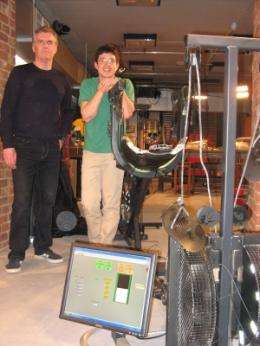Dr. Ian Swaine and Dr. Yan in the 'Bang goes the theory studios.'
An academic from Canterbury Christ Church University has disproved the theory 'you need water to swim' on a prime time television show.
Dr. Ian Swaine, a Reader in Sport and Exercise Science in the Department of Sport Science, Tourism and Leisure, has invented, and built a whole-body, front-crawl, swimming training machine which can be used as a land-training aid for improving the strength and fitness of swimmers and triathletes.
Last month Dr. Swaine took his dry-land swimming training machine along to television studios to prove to Dr. Yan, from the BBC One program, ‘Bang goes the theory’, that the water isn’t a necessity when swimming. And you can see the results this Monday (May 2) on BBC One at 7.30pm.
Dr. Swaine said:”It was a great opportunity for the swimming training machine to appear on national television.
“I am a former competitive swimmer and have been interested in developing dry-land swimming machine to test the mechanical efficiency of swimming, for years. It isn’t possible to get an accurate measure of this in the water, because the water ‘moves away’ when the limbs apply forces. So, I realized that the only way to find out how efficient swimmers are is by creating a machine. This particular machine has had two prototypes built, over the last 15 years. It’s fantastic to finally be able to show it to people and prove my theory that dry-land training for swimming is not only possible, but also helpful in understanding how efficient swimmers are”
The machine involves four resistance air-dynes, which are driven by the arms and legs, using pulley ropes. It also involves a freely-moving suspended ‘body cradle’ in which the swimmers lay down, allowing the body to roll, as it does in water. The swimmer places their hands into ‘hand paddles’ and their feet into ‘foot plates’ to drive the air-dynes. The leg air-dynes are driven in the ‘down’ and ‘up’ phases of the kicking action for each leg in exactly the same way as in the water.
The power being generated at each air-dyne is monitored by ‘sensors’ and fed into a computer where it is displayed as ‘individual limb power output’ for the swimmer. Power output can then be used to calculate mechanical efficiency. Also, each air-dyne can be operated independently and therefore this machine is suitable for use by paraplegics or amputees.
The data collected so far using the machine has been used in research on the efficiency of swimmers and how they adapt to different training practices, some of which has been already been presented at various conferences. Last year Dr. Swaine presented work he has done using this unique machine in Oslo (Sweden), Indianapolis (USA) and Verona (Italy).
Provided by Canterbury Christ Church University



















